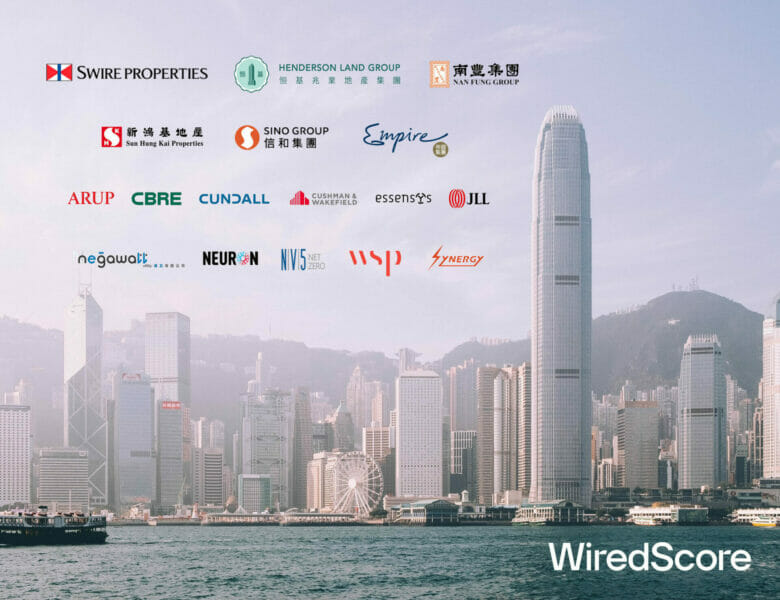
The leading Hong Kong landlords already working with WiredScore
A modern office building is very difficult to maintain without one key factor: technology. As consumers, we have become accustomed to tech-enablement across all areas of our lives, from education to exercise, entertainment to e-commerce. This reliance on technology in our personal lives has normalised a new level of speed, accessibility and convenience.
Our real estate needs to evolve with these ever-changing expectations. Gone are the days when office workers were satisfied with soulless cubicles and a few meeting rooms. Now our offices need to adapt seamlessly to users and provide an unparalleled experience to attract and retain employees. Smart buildings are no longer a “nice-to-have”, they are an essential. In fact, in Hong Kong, 96 percent of office occupiers responding to WiredScore’s survey said they would be prepared to pay a premium to work in a smart building. The demand is there — but is the infrastructure?
It is estimated that 80 percent of existing office buildings will still be in-use in 2050. Furthermore, with the real estate industry contributing approximately 40 percent of global carbon emissions, 11 percent of which originates from embodied carbon (GHG emissions associated with building construction), the industry is under pressure to retrofit existing building stock. This reduces the need for new developments, which result in significant carbon usage. The question then becomes, how do we make these older assets both energy-efficient and fit for the modern office worker, a worker who has become accustomed to hybrid working and convenience in all aspects of daily life? The answer: a smart retrofit.
What Is Retrofitting?

Retrofitting means implementing cutting-edge software and hardware into an already operational building to help improve its performance for users. This not only includes utilising technologies to increase energy efficiency, but also to improve the overall user experience. For example, this could involve adding new user features like contactless entry, smart lifts, occupancy sensors and more.
Why Retrofit?
Having smart, sustainable buildings is a priority for tenants. In Hong Kong, 98 percent of occupiers surveyed by WiredScore stated that it was important for their landlord to use technology to make their buildings sustainable. In today’s competitive office leasing market, landlords cannot afford to risk obsolescence. By retrofitting their properties, landlords will be able to improve the energy efficiency of their buildings, as well as the user experience. They can collect data that enables them to continually optimise and adapt their spaces.
A building that has been retrofitted with smart technology is also much easier and more cost-efficient to run. The real-time monitoring of energy consumption, alongside occupancy patterns and other data sets, enables landlords to identify opportunities to improve efficiency, increase uptime, and reduce ongoing maintenance and equipment costs.
Moreover, retrofitting a building includes updating policies around cybersecurity and data privacy. With over 50 percent more cyber attacks on corporate networks in 2021 than in 2020, it’s critical that landlords have the necessary cyber security and data management policies and procedures in place to attract significant global and local occupiers.

It is often assumed that the costs associated with retrofitting are too high to justify, especially in the short term. This may have been the case a decade ago; but with today’s rapid advancements in technology, it is no longer true. The Internet of Things in particular has opened the door to developing truly connected buildings at more affordable rates. Most commercial buildings will have a Business Management System in place already, which can dynamically adjust the temperature and lighting. However, with the enhancements provided by smart technologies, a building’s BMS can be optimised. In this way, landlords can identify opportunities to turn off lights or heating when the building’s occupancy is below a certain level.
It’s Time to Think Smarter
By working closely with leading landlords, occupiers and developers around the world, WiredScore has established a global standard for smart buildings and smart retrofits: SmartScore. This framework is recognised by the Royal Institution of Chartered Surveyors in their International Building Operating Standards and supports landlords and owners embarking on portfolio or individual asset enhancement programmes to develop a “smart roadmap” to meet ever-evolving user expectations. Indeed, a remarkable 96 percent of Hong Kong occupiers surveyed by WiredScore believe it is integral for offices to be technologically advanced.

Thomasin Crowley, Global Director of APAC at WiredScore
WiredScore’s recent launch in Hong Kong offers a significant opportunity for the city’s buildings to become smarter and better connected. The leading Hong Kong landlords already working with WiredScore include Swire Properties, Henderson Land Group, Nan Fung Group and Sun Hung Kai Properties, plus a joint venture between Sino Group and Empire Group. With 11 Accredited Professional Partner organisations (including Arup, Cundall, WSP, JLL, Cushman & Wakefield and CBRE) working alongside WiredScore, Hong Kong is well-positioned to ensure that its offices remain globally competitive.
Interested in learning how landlords in Hong Kong are standing out from the crowd? Download our full report here.
Leave a Reply